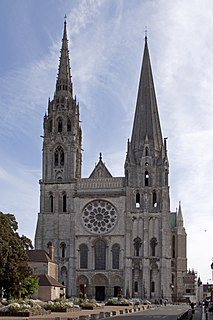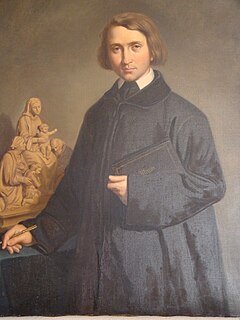Biography
Valentin de Bournonville was the son of Jean de Bournonville, and trained by his father in the mastery of the Amiens Cathedral. He was a priest. In 1634 he took over the position of master of the children of the cathedral, succeeding Artus Aux-Cousteaux, who himself had succeeded Jean de Bournonville. In 1643, an act of 23 July shows him depositing his almuce on the desk of the chapter as a sign of obedience, like the other vicars and chaplains of the cathedral. [1] In 1646, when he had two masses published by Robert III Ballard, he is said to be a canon of the church of St. Firmin d'Amiens and master of the children of the cathedral church of that city. He was also endowed with the Vicariate Chapel of Saint-Quentin. [2]

Jean de Bournonville was a French composer active in the first third of the 17th century, born in Noyon around 1585 and died in Paris on 27 May 1632. He should not be confused with his son Valentin de Bournonville, who published masses in the middle of the 17th century.

The Cathedral Basilica of Our Lady of Amiens, or simply Amiens Cathedral, is a Roman Catholic church. The cathedral is the seat of the Bishop of Amiens. It is situated on a slight ridge overlooking the River Somme in Amiens, the administrative capital of the Picardy region of France, some 120 kilometres north of Paris.

Artus Aux-Cousteaux was a French singer and composer, active in Picardy and Paris.
Valentin de Bournonville then moved to Paris, being appointed on 27 August 1646 as the music master of the Cathédrale Notre-Dame de Paris, until 20 March 1653, [3] succeeding here François Cosset. On 14 April 1651, the chapter reminded him that during the days of great feast, only a psalm and the magnificat were to be sung in music, and the rest by plain chant only. [4] On 21 September 1651 he had been invited by Pierre Robert, then music master of the Chartres Cathedral, to sing there. [5] On 15 April 1652, he was reprimanded at the time of the Chapter session for not showing enough severity towards the children of the choir and obtaining only insufficient progress. [6] In 1653, the chapter granted him a profit of the Église Saint-Jean-le-Rond de Paris .
François Cosset was a French composer. His works include 8 masses, 4 of them composed at Reims in 1659.
Pierre Robert was a French composer and early master of the French grand motet.

Chartres Cathedral, also known as the Cathedral of Our Lady of Chartres, is a Roman Catholic church in Chartres, France, about 80 km southwest of Paris. Mostly constructed between 1194 and 1220, it stands at the site of at least five cathedrals that have occupied the site since Chartres became a bishopric in the 4th century. It is in the Gothic and Romanesque styles.
He succeeded Pierre Robert as music master at the cathedral of Chartres until 1662. [7] He was sometimes called upon in the same way as Pierre Robert to attest to the good quality of the plainchant works by Guillaume-Gabriel Nivers, this double approval being given on 14 December 1657. He also signed the approval of the Directorium chori by Martin Sonnet in 1656.
Guillaume-Gabriel Nivers was a French organist, composer and theorist. His first livre d'orgue is the earliest surviving published collection with traditional French organ school forms. Nivers's other music is less known; however, his treatises on Gregorian chant and basso continuo are still considered important sources on 17th century liturgical music and performance practice.
He reappeared at Notre-Dame de Paris from October 1663 to the following 1 December, when he was replaced, perhaps because of his death.

Notre-Dame de Paris, also known as Notre-Dame Cathedral or simply Notre-Dame, is a medieval Catholic cathedral on the Île de la Cité in the fourth arrondissement of Paris, France. The cathedral is considered to be one of the finest examples of French Gothic architecture. The innovative use of the rib vault and flying buttress, the enormous and colorful rose windows, and the naturalism and abundance of its sculptural decoration all set it apart from earlier Romanesque architecture.
He was also quoted by Annibal Gantez, in 1643: comme un [Jean de] Bournonville qui est mort maistre de la Saincte Chapelle, et qui a laissé son fils aussi vertueux que luy maistre de l'Église d’Amiens. [8]
Annibal Gantez was a French composer and singer from the Baroque era. He is undoubtedly one of the most striking examples of a "vicarious" chapel master, that is, moving from post to post to earn a living, as many of his 17th century colleagues did. His route can be traced from two types of sources: letters from L’Entretien des musiciens, which he published in 1643, and various archival documents.
He died in Paris in 1663.






